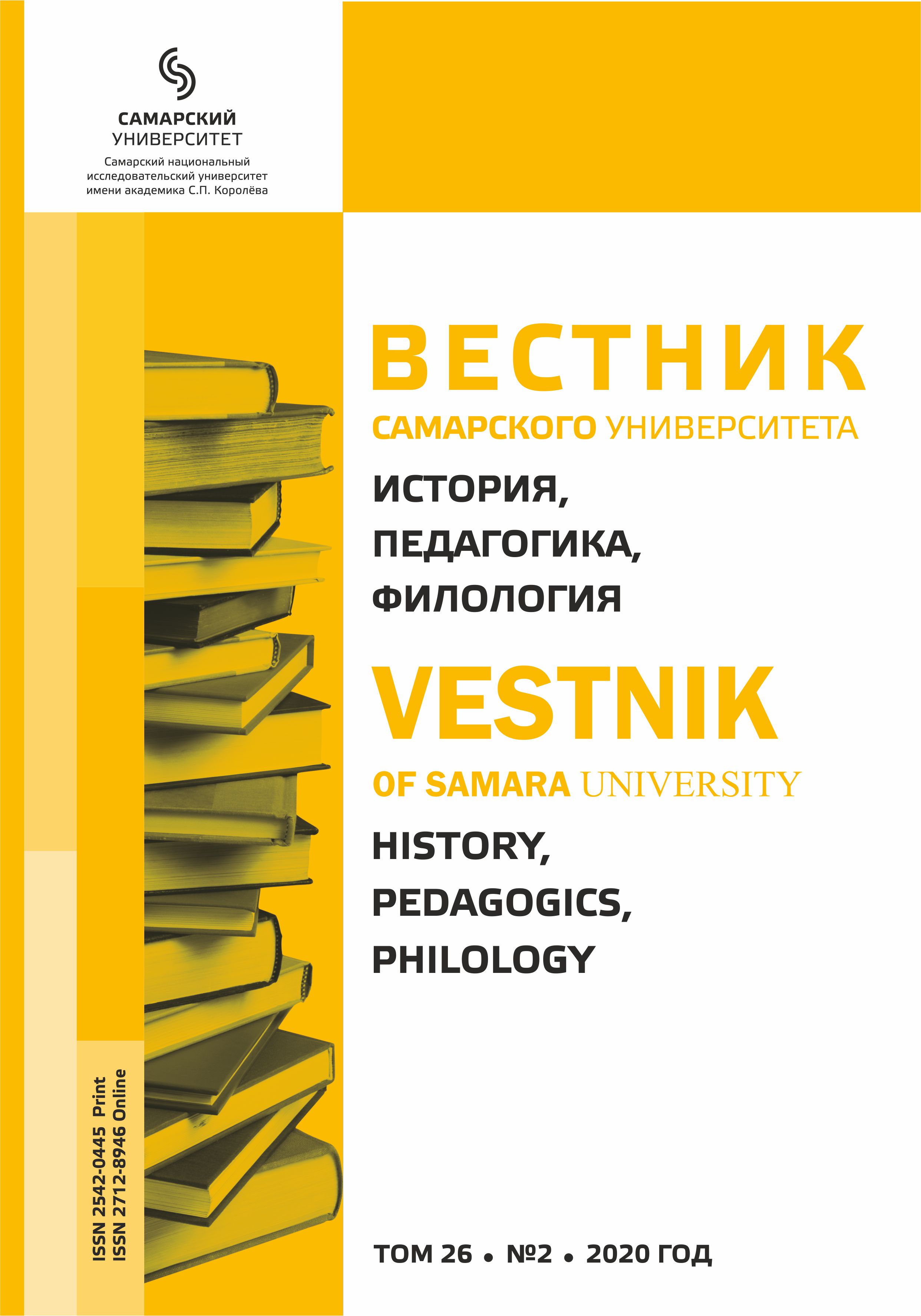Using the associative method of studying the text during university classes in literary disciplines
- Authors: Golubkov S.A.1
-
Affiliations:
- Samara National Research University
- Issue: Vol 26, No 2 (2020)
- Pages: 84-89
- Section: Articles
- URL: https://journals.ssau.ru/hpp/article/view/7876
- DOI: https://doi.org/10.18287/2542-0445-2020-26-2-84-89
- ID: 7876
Cite item
Full Text
Abstract
The article deals with the productive possibilities of the associative method of studying a literary text at university classes in literary disciplines. The student's creative thinking is characterized by the ability to generate new and sometimes unexpected semantic connections. Creative thinking largely depends on the so-called associative flexibility. There are several areas in the university teaching of literary studies in which the associative method of studying the text is effective. These are areas determined by the specifics of the type of artistic thinking, the specifics of a particular genre, and the individual manner of the writer. The method of developing associative thinking is important in the study of lyrical prose, where the specific weight of subtextual semantic nuances is high. Another area of literary studies in which an associative method of understanding a text is appropriate is the study of irony, including parody as «ironic stylization». The very process of laughable reinterpretation of a foreign» word implies the presence of a potential arsenal of situational associative references. At the same time, classes in literary studies use not only literary texts that are part of the main body of Russian literature, but also the range of phenomena that belongs to the so-called «creative laboratory» of the writer: writer's diaries, notebooks, work records, epistolary heritage. The method of associative study of the text can be used in the course of classes on «practical poetics», where students comprehend all the complexities of the artistic form of a literary work. Using the associative method of studying a literary text helps to better understand the nature of the dialogical interaction between the writer and the reader, because a literary work is nothing more than a «replica» in the ongoing communication between the author and the recipient of his creation. This communication has its own hidden languages. A literary work can be called a meaning-intensive space of meeting and touching the associative fields of the writer and the reader. The educational tasks that can be solved by the associative method of learning are diverse. This technology helps to effectively assimilate special terminology; understand internal system connections in a literary text; establish significant connections between a specific literary phenomenon and the historical and literary context, cultural epoch; form and enrich connections between a specific writer's manner (stylistic originality) and the national Fund of the Russian language; identify cross-references between a specific literary phenomenon and the national cultural code; to determine the balance of traditional and innovative in relation to a specific literary text.
About the authors
S. A. Golubkov
Samara National Research University
Author for correspondence.
Email: morenov@ssau.ru
ORCID iD: 0000-0003-3423-1520
Doctor of Philological Sciences, professor, professor of the Department of Russian and Foreign Literature and Public Relations
References
- Aloe 2012 – Aloe S. (2012) A garland from skaz: a fantastic circular path across the levels of narration, between irony and naiveness (with examples by Isaac Babel, Tat'jana Tolstaja and Jorge Amado). In: Studia Rossica Posnaniensia. Zeszyt XXXVII. Poznań: Uniwersytet im. Adama Mickiewicza w Poznaniu, pp. 13–23. Available at: http://bazhum.muzhp.pl/media/files/Studia_Rossica_Posnaniensia/Studia_Rossica_Posnaniensia-r2012-t37/Studia_Rossica_Posnaniensia-r2012-t37-s13-23/Studia_Rossica_Posnaniensia-r2012-t37-s13-23.pdf. (In Russ.)
- Bakhtin 2008 – Bakhtin M.M. (2008) Collected works: in 7 vol. Vol. 4 (I). Moscow: Izdatel'stvo «Russkie slovari», 1120 p. Available at: https://b-ok.cc/book/3048036/7f77f7. (In Russ.)
- Bakhtin 2010 – Bakhtin M.M. (2010) Collected works: in 7 vol. Vol. 4 (II). Moscow: Izdatel'stvo «Russkie slovari», 752 p. Available at: https://vk.com/wall-67308657_4551. (In Russ.)
- Belova 2010 – Belova N.Yu. (2010) Subject and object of perception in various systems of artistic interaction. Tomsk State University Journal, no. 333, pp. 141–144. Available at: http://sun.tsu.ru/mminfo/000063105/333/image/333-141.pdf. (In Russ.)
- Brainin 2006 – Brainin T.D. (2006) Associative relationships of words as a basis for image creation in the works of Sasha Sokolov: author's abstract of Candidate's of Philological Sciences thesis. Moscow, 2006, 26 p. Available at: http://cheloveknauka.com/v/169456/a?#?page=1. (In Russ.)
- Vygotsky 2019 – Vygotsky L.S. (2019) Psychology of art. Moscow: Eksmo, 288 p. Available at: https://www.marxists.org/russkij/vygotsky/art/psichologia-iskusstva.pdf. (In Russ.)
- Gay 1975 – Gay N.K. (1975) Fiction of literature: Poetics. Style. Moscow, p. 359. Available at: http://biblio.imli.ru/index.php/teor-litr/343-Gej-NK-Hudozhestvennost-literatury-Poetika-Stil-1975. (In Russ.)
- Zhukova 2008 – Zhukova V.A. (2008) Nature of associative background in the novel «Pushkin's house» by A. Bitov. In: Word-text-meaning: collection of scientific works. Yekaterinburg, 2008, issue 3, pp. 41–45. Available at: http://elar.urfu.ru/bitstream/10995/3367/2/word_text_sense_3_9.pdf.
- Osovsky 2015 – Osovsky O.E. (2015) Laughter word as one of the aspects of M.M. Bakhtin's legacy. Aktual'nye problemy gumanitarnykh i estestvennykh nauk, no. 8–2, pp. 24–28. Available at: https://cyberleninka.ru/article/n/smehovoe-slovo-kak-odin-iz-aspektov-naslediya-m-m-bahtina. (In Russ.)
- Rudnev 1997 – Rudnev V.P. (1997) Dictionary of culture of the XX century: key concepts and texts. Moscow: Agraf. (In Russ.)
- Shchirova, Goncharova 2007 – Shchirova I.A., Goncharova E.A. (2007) Multidimensional text: understanding and interpretation. Saint Petersburg: OOO «Knizhnyy Dom», 472 p. Available at: http://window.edu.ru/resource/249/64249/files/shirova.pdf. (In Russ.)
Supplementary files













